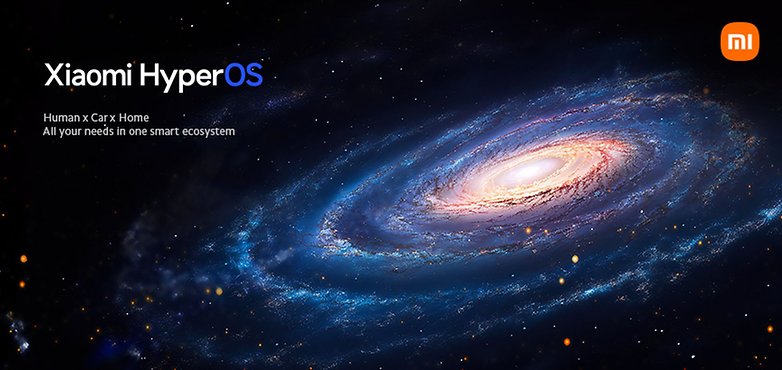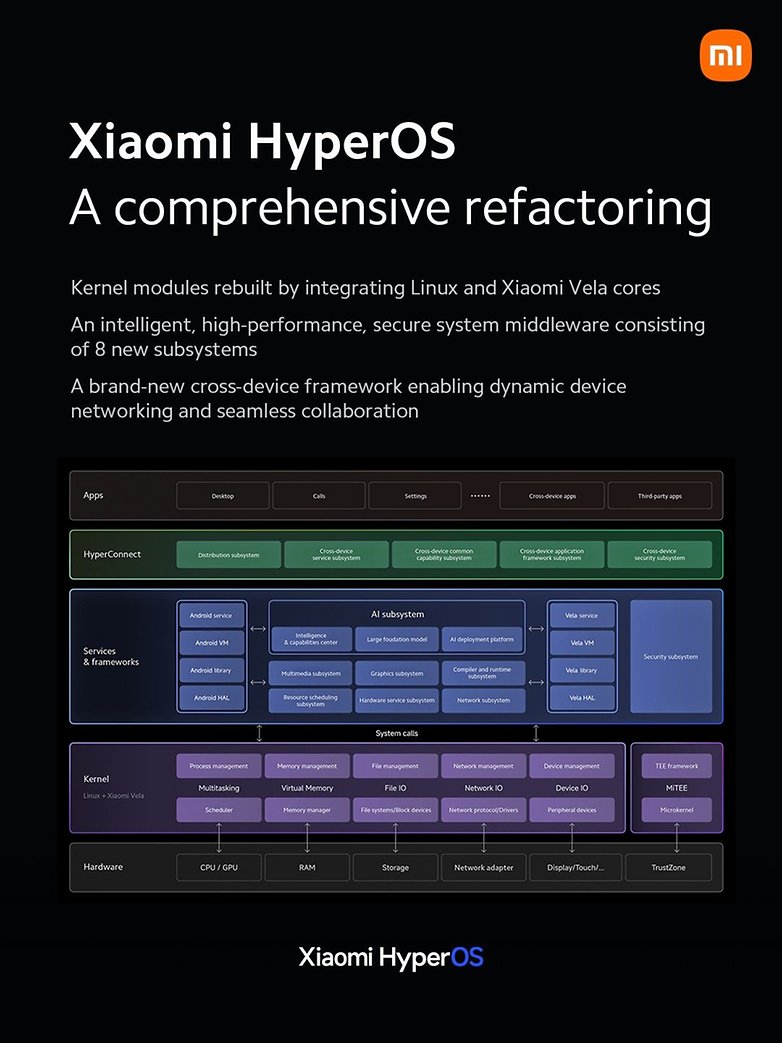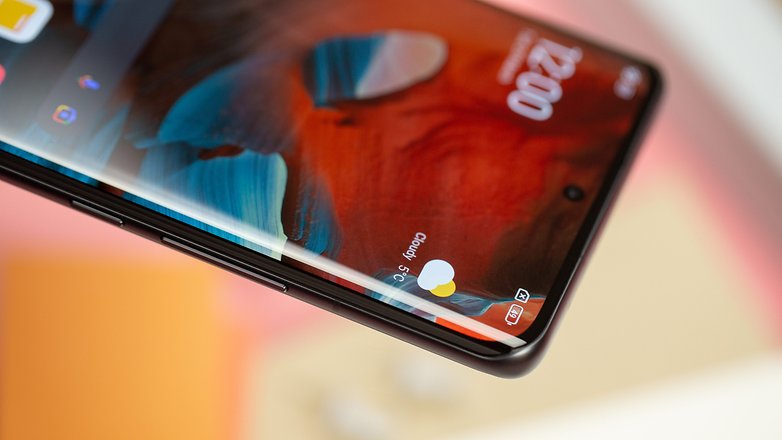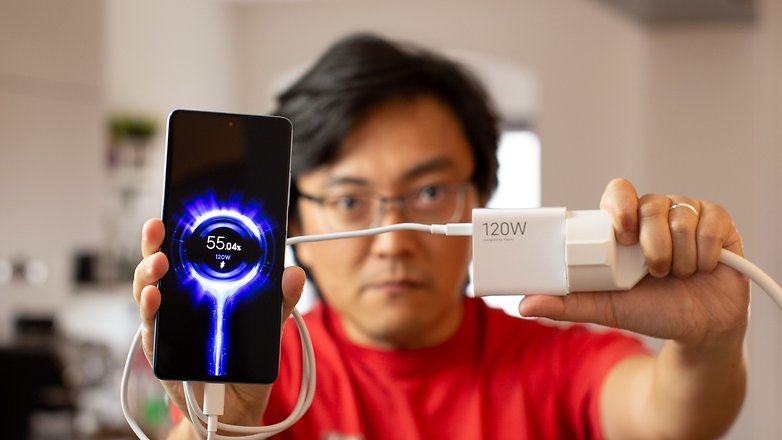When Xiaomi introduced the Redmi K60 Ultra in the Chinese market at the beginning of August, MIUI 15 was mentioned officially for the first time. However, MIUI suddenly became history in mid-October when Xiaomi unveiled HyperOS as its new software for the very first time. In fact, at least in China, HyperOS was already launched with the Xiaomi 14 and Xiaomi 14 Pro.
Table of Contents:
This is HyperOS
Xiaomi has made one thing very clear: We are not supposed to think that "HyperOS" is simply a new label for an operating system skin that is based on Android just like MIUI. In its own words, Xiaomi HyperOS has been in development since 2017 and Xiaomi wants to "bring coherence to the IoT landscape" with it.
The self-professed goal for Xiaomi is to not only deliver peak hardware performance but also to ensure a consistent user experience and provide seamless connectivity between all Xiaomi devices.

What does this mean for users? HyperOS is not just the user interface that greets us on Xiaomi, Redmi, and Poco smartphones, but the HyperOS experience will also make its way into the smart home and, as Xiaomi explicitly emphasized, into the upcoming Xiaomi car.
HyperOS: Linux, Xiaomi, and a little bit of Android
With a new system, it's worth taking a quick look under the hood. Linux and Xiaomi's self-developed Xiaomi Vela system form the core of Xiaomi HyperOS. As Xiaomi revealed, HyperOS supports over 200 processor platforms and over 20 standard file systems, covering hundreds of device types and thousands of SKUs.
Supported RAM sizes range from 64 KB to 24 GB. It is also worth noting that the firmware on smartphones will be comparatively slim at 8.75 GB, while competitors often require more than double the space.
The vocabulary "Android" is almost absent in Xiaomi's press release about HyperOS, which is interesting to note. Nevertheless, Android is also an integral part of HyperOS, albeit a less important one than with MIUI. While the Android framework and Android services are still supported, this points to compatibility with many apps.
HyperOS is supposed to be particularly performance and energy-efficient, which has a positive effect on smartphones, but should have an even stronger impact on IoT devices. Xiaomi explicitly stated that running resource-intensive games on a smartphone equipped with Xiaomi HyperOS ensures a more stable frame rate and lower power consumption compared to stock Android and the various skins.
Overall, the system was designed to work as efficiently as possible in each product class. Above all, the compatible devices should also be particularly effortless to integrate into your smart home and be controllable from anywhere. The following infographic shows you the structure of Xiaomi HyperOS:

In the infographic above, you can see the "HyperConnect" layer above the kernel and framework. This is supposed to ensure that all HyperOS can communicate with each other smoothly in real time. What Xiaomi meant by that was also described with a few examples during the presentation.
You can easily move your clipboard, notifications, or even apps from the smartphone to a notebook or tablet. You can also switch between different camera sources during video conferences, access your car's camera from your smartphone, or the main camera of your smartphone from your notebook.
Artificial intelligence and security are also supposed to be crucial cornerstones of HyperOS. Xiaomi sells us its new OS as a "human-centric, intelligent ecosystem for people, cars and home". We will tell you what's left of it beyond the marketing talk when we can look at a smartphone with HyperOS for the first time ourselves with a review-trained eye.
HyperOS: Availability
Good question, dear nextpit community. So far, only two HyperOS phones have been presented, the Xiaomi 14 and Xiaomi 14 Pro smartphones, which are intended exclusively for the Chinese market. HyperOS has been a reality in China since December, while the rest of the world still has to be patient.
As always, it will take a few weeks/months before a global version of Xiaomi's flagship smartphone is launched. We are currently assuming that Xiaomi will bring its Xiaomi 14 series to Europe in time for the MWC in Barcelona.
By then at the latest, HyperOS will also make it to Europe; Xiaomi CEO Lei Jun announced the global HyperOS launch via Twitter for the first quarter of 2024 anyway. But it won't take that long for you if you have the right smartphone. In this case, this "right smartphone" would not be a flagship, but the Poco F5!
HyperOS for the Poco F5 was also officially announced via Twitter and X, as you can see:
Xiaomi HyperOS rollout starts on POCO F5!
Owners of POCO F5 will be the first to experience Xiaomi HyperOS. Eligible users will receive the OTA update and be able to experience the new features.
Release plans for other models will be announced at a later date.
Follow us to get… pic.twitter.com/aNYbvRhFkN
— POCO (@POCOGlobal) December 18, 2023
HyperOS: Expected new features
With a few exceptions, the official HyperOS page from Xiaomi doesn't tell you much about the features that are coming with the new OS. So let's start with the functions that we officially know about:
Better multitasking and higher productivity
A new controller makes it easier to switch between windows and different window shapes. Split screens can be opened and closed independently of each other. An as yet unexplained feature called "Workstation" is designed to help you work even more productively on devices with a larger display - such as the Xiaomi Pad 6.
Uniform font MiSans Global
Xiaomi wants to create a "comfortable, cross-language reading experience" with HyperOS and has therefore launched the MiSans Global project together with Monotype Fonts and Hanyi Fonts to customize the fonts. It is an extensive font family that covers over 20 writing systems and supports more than 600 languages and more than 100,000 characters. As the standard font for the Xiaomi HyperOS system, it gives the devices a uniform visual style.
Individual lock screens
Similar to what we know from the iPhone, where individual lock screens can be created since iOS 16, such a feature is also available under HyperOS. Xiaomi calls them "Artistic Lock Screens", which allow you to customize the lock screens to your liking and make them look like magazine covers.

Xiaomi also talks about increased security on its website. This is to be ensured by a new security system called TEE. A secure data protection framework with end-to-end encryption is intended to provide comprehensive protection at the hardware level. In general, Xiaomi also promises increased security for system applications. We will certainly find out in the future whether this is marketing hype or whether security will actually be significantly increased.
Beyond this official information, there were a lot of leaks in the run-up to the launch, and we are now also seeing the first field reports such as the one linked here on Medium. In addition to the points already mentioned, the user a2zdrive has provided the following insights:
- Removing bloatware: It is reported that you can remove the dreaded bloatware under HyperOS relatively easily, which we are unfortunately used to from Xiaomi. Apps such as Mi Video, the gallery or even games can apparently be easily removed from the device.
- Clearer control center: You can access the quick settings directly from the main page of the control center, so you don't have to swipe to the side first.
- Redesigned Gallery app: The Gallery app has been completely turned inside out and is divided into three sections: Photos, Albums, and Suggestions. In the future, sections of images can be shared with a single tap.
- "Dynamic Island": Xiaomi doesn't even name this feature itself, but it is supposed to be reminiscent of Apple's Dynamic Island. For example, if you switch to silent mode, charge or switch on the hotspot, this visual element scores with an Apple-like aesthetic.
You will soon be able to read a final test of the Chinese version of the Xiaomi 14 Pro here and we will also get to the bottom of the software features by then at the latest.
These smartphones can expect to receive HyperOS
Now let's discuss the smartphones and tablets that we expect will receive MIUI 15 eventually. As you know from our Android 14 update tracker, we've divided the models we think will receive the MIUI 15 update into Xiaomi, Redmi, and Poco handsets. This list is unofficial, as we can only base it on Xiaomi's previous historical update pattern.
Therefore, this is a speculative list that should only serve as a general guide for you. As soon as we receive confirmed news, we will update this list accordingly. However, before that, you can take a look at the devices that Xiaomi has already confirmed will receive Android 14.
Xiaomi phones that will be officially updated to HyperOS

This is the official, albeit extremely short list.
| Officially confirmed |
|---|
| Xiaomi 12 |
| Xiaomi 12 Pro |
| Xiaomi 13 |
| Xiaomi 13 Pro |
| Xiaomi 13 Ultra |
| Xiaomi 13T |
| Xiaomi 13T Pro |
| Xiaomi 14 |
| Xiaomi 14 Pro |
| Xiaomi Pad 6 |
| Xiaomi Poco F5 |
| Xiaomi Poco F5 Pro |
| Xiaomi Redmi 12 |
| Xiaomi Redmi Note 12 |
| Xiaomi Redmi Note 12S |
Xiaomi phones that could be updated to HyperOS
On the other hand, the list of phones that we imagine will receive the update is far longer. Here, we listed the Xiaomi flagships, Redmi, and Poco models in separate tables. We will also keep updating these tables based on the latest information.
| Xiaomi model |
|---|
| Xiaomi 13 Lite |
| Xiaomi 11 Lite 5G NE |
| Xiaomi 11i 5G/Hypercharge |
| Xiaomi 11T |
| Xiaomi 11T Pro |
| Xiaomi 12 Lite(taoyao) |
| Xiaomi 12 Pro Dimensity Edition |
| Xiaomi 12S |
| Xiaomi 12S Pro |
| Xiaomi 12S Ultra |
| Xiaomi 12T(plato) |
| Xiaomi 12T Pro |
| Xiaomi 12X |
| Xiaomi Mi 11 |
| Xiaomi Mi 11 Lite |
| Xiaomi Mi 11 Lite 5G |
| Xiaomi Mi 11 Ultra |
| Xiaomi Mi 11i |
| Xiaomi Mi 11x |
| Xiaomi Mi 11X Pro |
| Xiaomi Mi Mix 4 |
| Xiaomi Mi Pad 5 |
| Xiaomi Mi Pad 5 Pro |
| Xiaomi Mi Pad 5 Pro 12.4 |
| Xiaomi Mi Pad 5 Pro 5G |
| Xiaomi Mix Fold 2 |
Redmi phones that could be updated to HyperOS

| Redmi model |
|---|
| Redmi 10 |
| Redmi 10 2022 |
| Redmi 10 5G |
| Redmi 10C |
| Redmi 11 Prime 5G |
| Redmi 12C |
| Redmi K50 |
| Redmi K50 Pro |
| Redmi K50 Extreme Edition |
| Redmi K50 Gaming Edition Poco F4 GT |
| Redmi K50i |
| Redmi Note 10 |
| Redmi Note 10 5G |
| Redmi Note 10 Lite |
| Redmi Note 10 Pro |
| Redmi Note 10 Pro 5G |
| Redmi Note 10S |
| Redmi Note 10T/10T 5G |
| Redmi Note 11 |
| Redmi Note 11 Pro 5G Poco X4 Pro 5G |
| Redmi Note 11 Pro+ 5G |
| Redmi Note 11 SE |
| Redmi Note 11S Poco M4 Pro |
| Redmi Note 11T Pro |
| Redmi Note 12 Pro |
| Redmi Note 12 Pro 4G |
| Redmi Pad |
Poco phones that could be updated to HyperOS
| Poco model |
|---|
| Poco C55 |
| Poco F4 5G |
| Poco F4 GT Redmi K50 Gaming |
| Poco M4 5G Redmi Note 11R |
| Poco M4 Pro Redmi Note 11S |
| Poco M4 Pro 5G |
| Poco M5 |
| Poco M5s Redmi Note 10S |
| Poco X3 GT |
| Poco X3 Pro |
| Poco X4 GT |
| Poco X4 Pro 5G Redmi Note 11 Pro 5G |
| Poco X5 5G |
| Poco X5 Pro |
Which features are coming to HyperOS, and which phones will Xiaomi officially support? Stay tuned for continuous updates on its international release here at NextPit. Is your Xiaomi model on the list? Share your HyperOS thoughts in the comments!
Article updated in January 2024 with the first confirmed models to receive HyperOS. Comments prior from the date were kept and may seen out of context.
Read More Open link https://ift.tt/u2zDKI4

0 Response to "Xiaomi HyperOS: Exploring New Features and the Compatibility List"
Posting Komentar